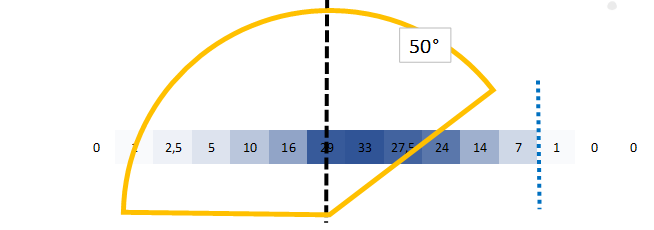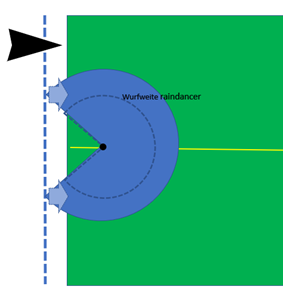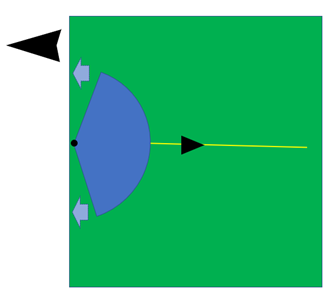The Effects of Wind
In connection with our sector control, one question that comes up frequently is: "What do I do in windy conditions?"
To provide a good answer, we began by taking measurements.
Side Wind
Situation:
The wind is blowing at sharp angles to the direction of travel, with a speed of approximately 25 km/h (Beaufort scale level 4). The values in the blue strips indicate the measured millimetres.
This is the reading for the measured wind drift:
Almost no water makes it outside when it's windy. Even if the stops were adjusted to throw more water in that direction, it would make no difference (0 multiplied by 2 is still 0).
In the centre, however, instead of 23 mm, we would have significantly more.
Thus, there's nothing we can do against the wind.
On the side facing away from the wind, we irrigate approx. 10 m - 15 m outside the field boundary.
So we moved the stop on the opposite side to 50°. This is what the measurement results look like:

As already mentioned above: there is nothing you can do against the wind.
On the side facing away from the wind, it is possible to keep the water in the irrigation run - it is not irrigated onto the neighbouring run.
With Raindancer sector control, stops can be adjusted, for example, for four hours. The farmer must personally determine the time, angle, and duration of these adjustments.
Deciding whether to turn off the irrigation and restart it when the wind is weaker depends not only on water distribution but also on technological considerations: for instance, if I halt the irrigation for four hours, will I still be able to cover the fields with the available hose reels?
Therefore, if the drift crosses a road, problems are inevitable.
Start and End Program
Scenario: The wind is blowing from the field towards the field border,
If the irrigation gun is at the beginning of its cycle, the Raindancer's throw range has little to no effect on the pivot point, causing potential drift outside the field boundary.
With Raindancer sector control:
Temporarily (e.g., for 10 minutes), the automatic sector control is switched off, and the stops are set as illustrated in the sketch.
The water will be directed towards the border, but it will not significantly cross the border.
Subsequently, you can resume using the Auto:ON mode with the throw distance as initially described.
Scenario: The wind blows onto the field.
 If you work with the real throwing distance, the turning point is where the water is pushed away from the border of the field and onto the field - the edge of the field itself does not get "anything".
If you work with the real throwing distance, the turning point is where the water is pushed away from the border of the field and onto the field - the edge of the field itself does not get "anything".
With the raindancer sector control:
The throwing distance in the Raindancer is entered as smaller than the actual throwing distance.
The stop is thus adjusted automatically to allow turning later than "with no wind".
The water blows onto the field and water also arrives at the border of the field!
These are our (limited) measurements and our interpretations.
For scientifically based statements, far more extensive measurements and analyses are needed. However, we simply didn't have enough time for this.
We can only say here what we have measured and what our conclusions are. Please take this with a grain of salt.
Über Reaktionen, also Rückfragen, Kritiken, Anmerkungen, Ergänzungen und Diskussionen würden wir uns sehr freuen!




No Comments